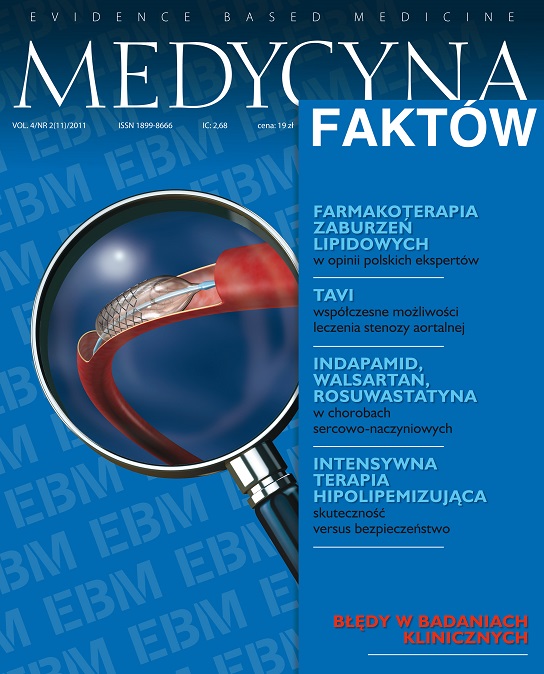Zespół niedokrwistości sercowo-nerkowej Artykuł przeglądowy
##plugins.themes.bootstrap3.article.main##
Abstrakt
Na zespół niedokrwistości sercowo-nerkowej składają się interakcje między przewlekłą niewydolnością serca, przewlekłą chorobą nerek i niedokrwistością. Są one następstwem uruchamianych przez organizm mechanizmów kompensacyjnych, które po przekroczeniu pewnych granic stają się niekorzystne, ponadto wzajemnie pogłębiają się na zasadzie „błędnego koła”. Dochodzi do pogorszenia funkcji serca i nerek, wystąpienia bądź dalszego nasilenia niedokrwistości. Każda z powyższych trzech jednostek chorobowych może wywołać pozostałe lub być przez nie spowodowana. Niedokrwistość zwiększa istotnie ryzyko zgonu. Leczenie za pomocą erytropoetyny, zmniejszające stopień niedokrwistości, powoduje regresję przerostu lewej komory, poprawia frakcję wyrzutową, zwiększa szanse przeżycia, a także poprawia jakość życia.
##plugins.themes.bootstrap3.article.details##
Copyright © by Medical Education. All rights reserved.
Bibliografia
2. Kosiborod M., Smith G.L., Radford M.J. et al.: The prognostic importance of anemia in patients with heart failure. Am. J. Med. 2003; 114: 112-119.
3. Silverberg D.S., Wexler D., Blum M. et al.: The use of subcutaneous erythropoietin and intravenous iron for the treatment of the anemia of severe, resistant congestive heart failure improves cardiac and renal function and functional cardiac class, and markedly reduces hospitalizations. J. Am. Coll. Cardiol. 2000; 35: 1737-44.
4. Ishani A., Weinhandl E., Zhao Z. et al.: Angiotensin-converting enzyme inhibitor as a risk factor for the development of anemia, and the impact of incident anemia on mortality in patients with left ventricular dysfunction. J. Am. Coll. Cardiol. 2005; 45: 391-9.
5. Felker G.M., Leimberger J.D., Califf R.M. et al.: A predictive model for the risk of death or rehospitalization after admission for decompensated heart failure: results from OPTIME-CHF study. Circ. 2001; 104(Suppl): II-689.
6. Horwich T.B., Fonarow G.C., Hamilton M.A. et al.: Anemia is associated with worse symptoms, greater impairment in functional capacity and a significant increase in mortality in patients with advanced heart failure. J. Am. Coll. Cardiol. 2002; 39: 1780-1786.
7. Keane W.F., Brenner B.M., de Zeeuw D. et al.: The risk of developing end-stage renal disease in patients with type 2 diabetes and nephropathy: The RENAAL Study. Kidney Int. 2003; 63: 1499-1507.
8. Li S., Collins A.J.: Association of hematocrit value with vascular morbidity and mortality in incident hemodialysis patients. Kidney Int. 2004; 65: 626-633.
9. Levin A.: Anemia and left ventricular hypertrophy in chronic kidney disease populations: A review of the current state of knowledge. Kidney Int. 2002; 61(Suppl 80): S35-8.
10. Foley R.N., Parfrey P.S., Harnett J.D. et al.: The impact of anemia on cardiomyopathy, morbidity, and mortality in end-stage renal disease. Am. J. Kidney Dis. 1996; 28: 53-61.
11. Harnet J.D., Kent G.M., Foley R.N. et al.: Cardiac function and hematocrit level. Am. J. Kidney Dis. 1995; 25: S3-S7.
12. Levin A., Thompson C.R., Ethier J. et al.: Left ventricular mass index in early renal disease: impact of decline in hemoglobin. Am. J. Kidney Dis. 1999; 34: 125-134.
13. Muntner P., He J., Astor B.C. et al.: Traditional and nontraditional risk factors predict coronary heart disease in chronic kidney disease: results from atherosclerosis risk in communities study. J. Am. Soc. Nephrol. 2005; 16: 529-38.
14. St Peter W.L., Xue J., Ebben J. et al.: Pre-end stage renal disease erythropoietin use predicts hospitalization in the periods before and after end-stage renal disease prognosis. J. Am. Soc. Nephrol. 2001; 12: 247A.
15. Zeidman A., Fradin Z., Oster H.S. et al.: Anemia is a risk factor for ischemic heart disease. Isr. Med. Assoc. J. 2004; 6: 16-18.
16. Fleker G.M., Kirkwood F.A., Gattis W.A. et al.: Anemia as a risk factor and therapeutic target in heart failure. J. Am. Coll. Cardiol. 2004; 44: 959-966.
17. Torre-Amione G., Bozkurt B., Deswal A. et al.: An overview of tumor necrosis factor alpha and the failing human heart. Curr. Opin. Cardiol. 1999; 14: 206-210.
18. Bolger A.P., Doehner W., Sharma R. et al.: Anemia in chronic heart failure: the relationship to inflammatory cytokine production and prognostic importance. Circ. 2002; 106: 2819.
19. Volpe M., Tritto C., Testa U. et al.: Blood levels of erythropoietin in congestive heart failure and correlation with clinical, hemodynamic and hormonal profiles. Am. J. Cardiol. 1994; 74: 468-473.
20. Silverberg D.S., Wexler D., Sheps D. et al.: The effect of correlation of mild anemia in severe, resistant congestive heart failure using subcutaneous erythropoietin and intravenous iron: a randomized controlled study. J. Am. Coll. Cardiol. 2001; 37: 1775-1780.
21. Mancini D.M., Katz S.D., Lamanca J. et al.: Effect of erythropoietin on exercise capacity in patients with moderate to severe chronic heart failure. Circ. 2003; 107: 294-299.
22. Hirata A., Minamino T., Asanuma H. et al.: Erythropoietin enhances neovascularization of ischemic myocardium and improves left ventricular dysfunction after myocardial infarction in dogs. J. Am. Coll. Cardiol. 2006; 48: 176-184.
